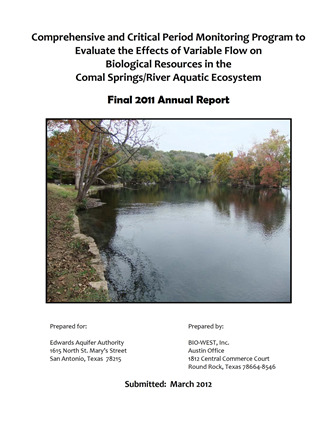Comprehensive and Critical Period Monitoring Program to Evaluate the Effects of Variable Flow on Biological Resources in the Comal Springs/River Aquatic Ecosystem Final 2011 Annual Report

| Summary |
|
The purpose of this report is to document the results of all aquatic ecosystem monitoring conducted in 2011 at Comal Springs located in New Braunfels, Texas. The monitoring and report preparation was performed by BIO-WEST, Inc. Pflugerville, Texas. [Excerpted from Executive Summary] Less severe, but negative effects on aquatic vegetation and fountain darter populations were evident in Landa Lake during the majority of 2011. Aquatic vegetation and fountain darter conditions within the Old Channel remained consistent with post-culvert reconstruction conditions, while New Channel conditions improved during 2011. Neither water quality parameters measured (including water temperature) throughout the Comal Springs/River ecosystem, nor endangered macroinvertebrate habitat or population data posed concern during the extended drought witnessed in 2011. As such, the juxtaposition of high and low-flow events in 2010 and 2011 caused impacts (some severe) in the certain reaches of the ecosystem, but overall the aquatic communities presently remain intact. As the drought continues, or is broken it will be invaluable to continue to monitor the response and/or recovery of the Comal Springs/River ecosystem. |
Search for Documents
Advance Search
Explore EAA's Scientific Reports
- All Reports
- Hydrology and Hydrogeology
- History
- Groundwater Recharge, Recharge Zone
- Groundwater Movement
- Geomorphology and Caves
- Weather Modification
- Geology
- Water Use and Conservation
- Geochemistry
- Water Resources Planning and Management
- Floods and Drought
- Water Quality
- Climatology
- Surface Water / Groundwater Relationship
- Biology
- Springs, Groundwater Discharge
- Archaeology
- RZ Protection
- Aquifer Levels
- Remote Sensing
- Precipitation
- Overview Studies
- Modeling
